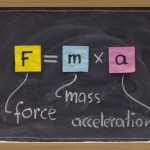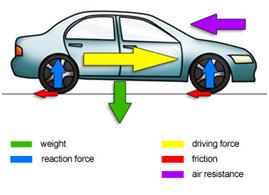Car Basics – Sir Isaac Newton’s Laws of Motion
Free Car Insurance Comparison
Compare Quotes From Top Companies and Save
Secured with SHA-256 Encryption
Kristen Gryglik
Licensed Insurance Agent
Kristen is a licensed insurance agent working in the greater Boston area. She has over 20 years of experience counseling individuals and businesses on which insurance policies best fit their needs and budgets. She knows everyone has their own unique needs and circumstances, and she is passionate about counseling others on which policy is right for them. Licensed in Massachusetts, New Hampshire,...
Licensed Insurance Agent
UPDATED: Jul 12, 2024
It’s all about you. We want to help you make the right coverage choices.
Advertiser Disclosure: We strive to help you make confident car insurance decisions. Comparison shopping should be easy. We are not affiliated with any one car insurance company and cannot guarantee quotes from any single company.
Our partnerships don’t influence our content. Our opinions are our own. To compare quotes from top car companies please enter your ZIP code above to use the free quote tool. The more quotes you compare, the more chances to save.
Editorial Guidelines: We are a free online resource for anyone interested in learning more about auto insurance. Our goal is to be an objective, third-party resource for everything auto insurance related. We update our site regularly, and all content is reviewed by auto insurance experts.
UPDATED: Jul 12, 2024
It’s all about you. We want to help you make the right coverage choices.
Advertiser Disclosure: We strive to help you make confident car insurance decisions. Comparison shopping should be easy. We are not affiliated with any one car insurance company and cannot guarantee quotes from any single company.
Our partnerships don’t influence our content. Our opinions are our own. To compare quotes from top car companies please enter your ZIP code above to use the free quote tool. The more quotes you compare, the more chances to save.
Sir Isaac Newton was an English scientist who lived in the 17th and 18th centuries and who made many advances in the fields of mathematics and physics. In 1687 he published a series of three books

collectively known as the Philosophiæ Naturalis Principia Mathematica, where he explained what he called the Three Laws of Motion. The First Law of Motion pertained to inertia, the Second Law of Motion explained the principles behind acceleration, and the Third Law of Motion asserted that every force was accompanied by an equal and opposite force. He drew inspiration from many scientists that came before him, most notably Galileo Galilei and Rene Descartes. Isaac Newton’s theories on motion, as well as gravity, are widely regarded by the scientific community as the most important contributions by a single person in the history of the sciences.
First Law of Motion
Newton’s First Law of Motion, which is also referred to as the Law of Inertia, states that an object will not change its speed or direction unless an outside force acts upon it. This means that an object that is not moving, will not move unless something pushes it, and an object that is moving, will need some external force to change its direction or slow it down. Newton’s law of inertia contradicted many existing theories of the time, not the least of which was the belief that an object in motion needed some kind of force to keep it in motion. This law of motion means, for instance, that once a car is put into motion, it will continue to stay in motion, unless another force acts against it. The fact that the car eventually comes to a stop, is not due to the lack of a force, but rather the presence of an opposing force, which is most commonly the force known as friction.
- The Physics Classroom: Newton’s First Law
- Georgia State University: Department of Physics & Astronomy – Newton’s First Law
- Physics in Sports Connection: Newton’s First Law
- The Community College of Baltimore County: Lecture 1 – Newton’s First Law of Motion
Second Law of Motion

Newton’s Second Law of Motion is commonly known as the Law of Acceleration. It says that when an object in motion encounters some kind of force, its direction and speed, also known as its momentum, will change in the direction from which the force is applied. In addition, the change in momentum is inversely proportional to the object’s mass. This means that with a given force, the smaller the object’s mass, the greater the change in momentum, and the greater its mass, the less its momentum will change. For example, a basketball or a car that is rolling downhill will accelerate because of an outside force called gravity. When either object encounters a breeze from the left, Newton’s Second Law of Motion dictates that the breeze is more likely to cause a visible change in the basketball’s speed and direction, than that of the car, because of the difference in mass between the two objects. Furthermore, since the breeze from the left is blowing to the right, the basketball’s change in momentum will cause it to curve toward the right. The car’s change in momentum will be so minor that an observer won’t notice it.
- Wisc-Online: Newton’s Second Law of Motion
- Batesville Community School Corporation: Newton’s Second Law
- East Buchanan Community Schools: Newton’s Laws of Motion
- Codman Academy Charter Public School: The Physics of Driving
- Zona Land Education: Isaac Newton’s Second Law of Motion
Third Law of Motion
Newton’s Third Law of Motion, the law of actions and reactions, states that when a force acts upon an object, an equal and opposite force is applied at the same time. In simpler terms, when something pushes an object, the object pushes back with equal force. This is why when two skaters push against each other, they will both move away from each other, with the heavier person moving less than the lighter person. When a car’s engine starts and makes its wheels spin, its wheels push against the road, and the road applies an opposing force that enables the car to move forward.
- The University of Tennessee, Knoxville: Newton’s Three Laws of Motion
- Pop Physics: Newton’s Third Law
- Mansfield Public Schools: Newton’s Third Law of Motion
- California State University at Sonoma: Newton’s Third Law
- BBC: Newton’s Third Law
Quizzes
- Three Laws of Motion Quiz
- Newton’s Laws of Motion Interactive – Quiz
- Quiz Yourself – Newton’s Laws of Motion
- Newton Laws of Motion Quiz
- Physical Science: Motion, Forces, and Energy, Book M – Online Quiz
Lesson Plans
- Lesson Plan Title: Newton’s Laws of Motion (PDF)
- Physical Science Lesson Plan: Forces – Laws of Motion
- Math Centre: Newton’s First Law of Motion (PDF)
- Newton and the Enlightenment
- Newton and His Laws – Grades 9 – 12
- Roaring Rockets Lesson Plan (PDF)
Games
- Amusement Park Physics
- Quiz Games: Quiz on Laws of Motion
- Galileo Drops the Ball
- Laws of Motion Rollercoaster Millionaire Game
- Law of Gravity Online Game
-
Car Insurance Quotes and Calculations
get car insurance online ~ how to save money on car insurance ~ free financial calculators list ~ new car insurance rates ~ get quote for car insurance ~ car insurance quotes comparison online

Enter your zip code below to view companies that have cheap auto insurance rates.
Secured with SHA-256 Encryption
Kristen Gryglik
Licensed Insurance Agent
Kristen is a licensed insurance agent working in the greater Boston area. She has over 20 years of experience counseling individuals and businesses on which insurance policies best fit their needs and budgets. She knows everyone has their own unique needs and circumstances, and she is passionate about counseling others on which policy is right for them. Licensed in Massachusetts, New Hampshire,...
Licensed Insurance Agent
Editorial Guidelines: We are a free online resource for anyone interested in learning more about auto insurance. Our goal is to be an objective, third-party resource for everything auto insurance related. We update our site regularly, and all content is reviewed by auto insurance experts.



